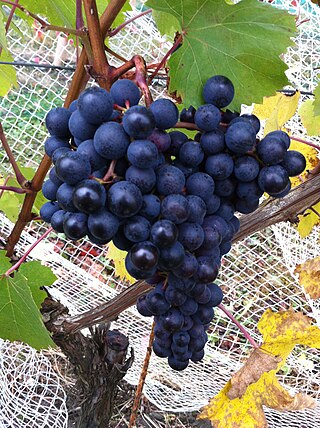
Dolcetto is a black Italian wine grape variety widely grown in the Piedmont region of northwest Italy. The Italian word dolcetto means "little sweet one", but it is not certain that the name originally carried any reference to the grape’s sugar levels: it is possible that it derives from the name of the hills where the vine is cultivated. In any case the wines produced are nearly always dry. They can be tannic and fruity with moderate, or decidedly low, levels of acidity and are typically meant to be consumed within a few years after release.

Trollinger, Schiava, or Vernatsch, is a red German/Italian wine grape variety that was likely first originally cultivated in the wine regions of South Tyrol and Trentino, but today is almost exclusively cultivated on steep, sunny locations in the Württemberg wine region of Baden-Württemberg. It is primarily known under the synonyms Trollinger in Germany, Vernatsch in South Tyrol and Schiava in other Italian regions. As a table grape the variety is sometimes known as Black Hamburg, which is commonly confused with the similar synonym for Black Muscat—a variety that is actually a cross of Trollinger and Muscat of Alexandria.

Arvier ; is a town and comune in the Aosta Valley region of northwestern Italy.

Chambave is a town and comune in the Aosta Valley region of northwestern Italy.
Breganze is a town in the province of Vicenza, Veneto, Italy. It is northeast of Via Romea. During World War II, the Germans were on one side of the river and the Allies were on the other, and a firefight occurred across the river.
Pineau d'Aunis is a red French wine grape variety that is grown primarily in the Loire Valley around Anjou and Touraine.

Mondeuse noire is a red French wine grape variety that is grown primarily in the Savoy region of eastern France. The grape can also be found in Argentina, Australia, California, Switzerland and Sicily. Plantings of Mondeuse noire was hit hard during the phylloxera epidemic of the mid to late 19th century which nearly wiped out the vine from eastern France. While the grape recovered slightly in the 20th century, French plantations of Mondeuse noire fell sharply in the 1970s, with just over 200 hectares left in France in 2000. In the early 21st century, it seems the variety has increased somewhat in popularity, as it can give good wines if the planting site is chosen carefully.
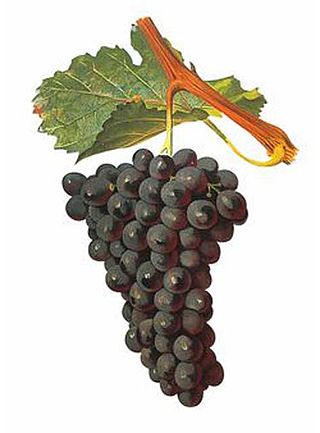
Terret noir is a dark-skinned French wine grape variety grown primarily in the Rhône valley region of France. It is a mutation of the old Vitis vinifera vine Terret. It is a permitted blending grape for Châteauneuf-du-Pape. Like the related Terret gris and Terret blanc, the vine tends to bud late and grow vigorously. Terret noir produces a light color wine that is perfumed and tart.
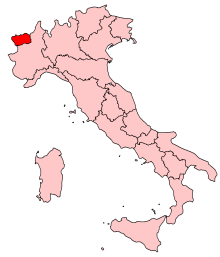
The Valle d'Aosta DOC is an Italian denominazione di origine controllata located in the Aosta Valley of north-west Italy. Surrounded by the Alps, the Valle d'Aosta is home to the highest elevated vineyards in all of Europe. The principal winemaking region of the Valle d'Aosta is found along the eastern banks of the Dora Baltea river with the city of Aosta serving as the central winemaking location. The region is divided into three main vineyard areas; the upper valley, Valdigne, the central valley and the lower valley,. To the south is the winemaking region of Piedmont. The Valle d'Aosta is Italy's smallest winemaking region both in terms of size and production with only about 330,000 cases produced annually in the region and only 36,000 cases produced under the DOC label. Seventy five percent of the area's production is red wine made mostly from the Pinot noir, Gamay and Petit Rouge varieties. A white wine is made from the indigenous Prié blanc grape by the cooperative of Blanc de Morgex et de La Salle.
Verdeca is a white Italian wine grape variety that is primarily grown in Apulia in southern Italy where ampelographers believe that the grape may have originated. In Apulia, it is one of the main grapes in the Denominazione di origine controllata wines of Locorotondo DOC and Martina Franca DOC along with Bianco d'Alessano. In Campania, it is grown on the slopes of Mount Vesuvius where it used as a blending variety with Falanghina, Coda di volpe and Greco in both the white wines and the sweet dessert wine of the region, Lacryma Christi. It is also a minor component used in the some vermouth production.
Perricone is a red Italian wine grape variety that is grown in Sicily. In the late 20th century there was around 1000 hectares/2,500 acres of the grape planted throughout the island. Red berry flavors and medium alcohol content are commonly attributed to Perricone wines, but Oz Clarke describes them as full-bodied and alcoholic.
Abrusco is a red Italian wine grape variety grown primarily in the Tuscany region where it is a minor blending component permitted in the wines of Chianti. The grape has long history in the region and was mentioned in 1600, under its synonyms Abrostino and Colore, in the posthumously published work by Italian agronomist Giovan Vettorio Soderini Trattato della coltivazione delle viti, e del frutto che se ne può cavare. There Soderini notes that the grape was often used to add deeper, more red color to Tuscan wines.

Pomino is a village belongs to the municipality of Rufina, in the province of Florence, region Tuscany. The village of Pomino is 7,36 kilometers far from the same town of Rufina to whom it belongs. The locality of Pomino rises 585 meters above sea level and the population counts 228 inhabitants.
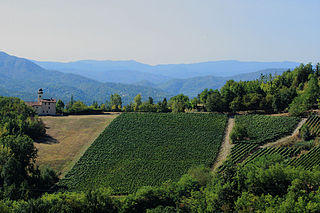
Brachetto d'Acqui is a red Italian wine that is classified as a Denominazione di Origine Controllata e Garantita (DOCG) since 1996 and previously a Denominazione di Origine Controllata (DOC) region since 1969. It is produced in the Piedmont wine region around Acqui Terme in the province of Alessandria with some overlap into the province of Asti. The wine is produced from the Brachetto grape, a variety that is believed to be native to Piedmont, and can be still or sparkling with usually some sweetness.
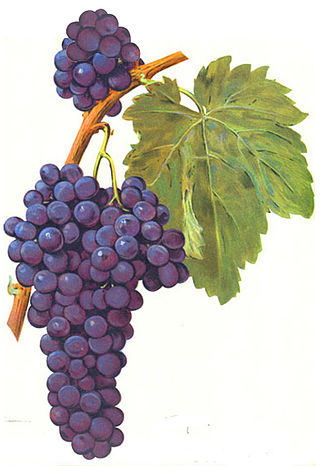
Petit Rouge is a red Italian wine grape variety that ampelographers believe is indigenous to the Valle d'Aosta region of northwest Italy. However, there is some confusion about whether Petit Rouge is the same variety as the red Swiss wine grape Rouge de Valais.
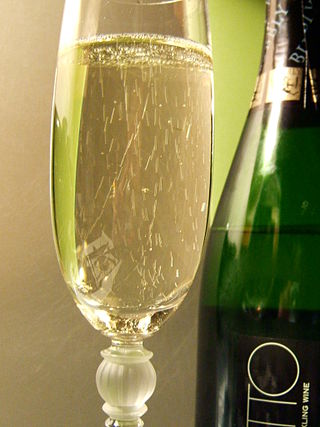
Verdiso is a white Italian wine grape variety grown primarily in province of Treviso in the Veneto wine region of northeast Italy. It is a permitted variety in the sparkling wine Denominazione di origine controllata DOC of Prosecco located north of the city of Treviso along the Piave river.
Pascale di Cagliari is a red Italian wine grape variety that is grown in Sardinia.
Neyret is a red Italian wine grape variety that is grown in the mountainous Valle d'Aosta wine region of northwest Italy though most plantings are in the slightly less mountainous terrain of southeast Aosta Valley bordering the Piedmont wine region. DNA profiling has confirmed that the variety is a Vitis vinifera crossing of Mayolet and Roussin.
Negrara is a red Italian wine grape variety grown in north east Italy including the Veneto region where it is a permitted variety in the Denominazione di origine controllata (DOC) wine Amarone. While the grape was once more widely planted in the region its numbers have been steadily declining for most of the late 20th and early 21st century.
Avanà is a red Italian wine grape variety that is grown in the Piedmont wine region of northwest Italy. Historically, the grape has also been grown in the Dauphiné and Savoie wine region of eastern France where it was known as Hibou noir and in the Valais region of Switzerland. The grape is most often used as a blending variety in the Denominazione di origine controllata (DOC) zones of Pinerolese, with Barbera, Persan, Freisa and Neretta Cuneese, and Valsusa, with Barbera, Dolcetto, Neretta Cuneese and other local red Piemontese varieties.











